
The destruction of indigenous peoples’ secular and religious emblems, specifically those related to the record of their past, is often a common theme in the study of the Spanish conquest of the New World. In the annals of archaeology and anthropology, one needs to investigate behind the scene to bring a sharper focus on events that are not often what they seem to be. The case of the Franciscan friar Diego de Landa Calderón’s auto-de-fe, or “act of faith,” at Mani, in the peninsula of Yucatan, Mexico, is the most significant example often regarded as the historical “landmark” concerning the destruction, or burning, of the Maya “books.” In his 1566 Relación de las Cosas de Yucatán, the friar documented the zeal and excess in his drive to “remove the demons” from the natives’ hearts. This story focuses on what led to that event and, specifically, what was really burned on July 12, 1562, and why……..
The Mission

Diego de Landa. Wikimedia Commons, Public Domain
Diego de Landa (1524-1579, portrait right) was among the first Franciscans to arrive in Yucatan. Part of Nueva España, or New Spain, it was then ruled by the Spanish viceroy and the Tribunal del Santo Oficio de la Inquisición (Holy Office of the Inquisition) in Mexico City, established by King Ferdinand II of Aragon and Queen Isabella I of Castile in 1478. Diego de Landa was born in the town of Cifuentes, in the Spanish province of Alcaria, on November 12, 1524. At that time, the Franciscan order in America had the religious monopoly in conquered lands and answered to the seat of the Holy Inquisition in Mexico City, administrator of religious affairs. Of note is the fact that the Treaty of Tordesillas of 1524 granted the rights of conquest of most of the Americas to Spain, with the understanding that the conquistadores would conquer land and riches for the Kings at Granada, but harvest souls for the Pope in Rome.
De Landa arrived in Merida from Spain in 1549, a few years after the death of his wife Inesa de Inchaurduy, with whom he had two sons, Diego and Juan. He renounced his position as Royal Notary and, in 1541, joined the Order of Friars Minor, a religious order of the Franciscans in the convent of San Juan de los Reyes in Toledo. His initial appointment in Mexico was to the mission, later convent, of San Antonio de Padua in the town of Izamal, Yucatan, where he became known as a hardworking friar. He undertook his mission by first learning the Yucatec language, walking barefoot as he visited villages on the peninsula, at that time divided into nineteen independent chiefdoms. He learned about the land, the people and local customs. His direct approach, sometimes in hostile villages where the legacy of the brutal conquest still lingered after 30 years, convinced him of his mandate to convert. He was, however, welcomed in many communities, and that helped him understand the people and his ecumenical mission. It was at that time that he saw figures and signs drawn or painted on sheets made of vegetal material, which he interpreted as idolatry and messages of the devil. They were, in fact, the only “written” record of the indigenous Yucatec communities.
___________________________________
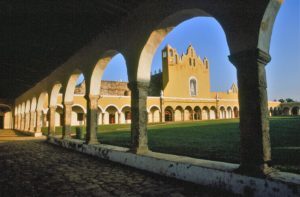
San Antonio de Padua Convent, Izamal ©georgefery.com
___________________________________
De Landa distinguished himself for his zeal in the conversion of the Mayas, resorting to excessive pressure and physical abuse. The Spanish Crown and the Inquisition, however, had already forbidden the use of duress to convert indigenous people, because it was understood that the Christian doctrine could not be grasped within a generation or two after the conquest. It was also unanimously understood that the Mayas, and other indigenous groups, needed more time to convert and, therefore, could not be guilty of heresies when they had no sense of what the Christian doctrine was all about. It took thirty-five to forty years for the religious orders to develop conversion protocols for indigenous people. The explicit mission of the Franciscans at that time was to protect the Maya communities from the abuses of the Spanish encomenderos, individuals that were duly recognized among the conquistadores of the land. As a reward for their military service to the crown, they received encomiendas or donations of populated lands; they were also called colonists.
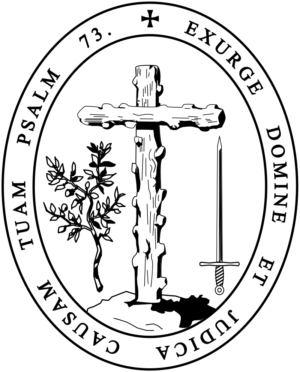
Seal of the Tribunal of the Holy Inquisition Public Domain
De Landa, however, ignored the Inquisition’s mandate to stop forced conversion and persisted in eradicating traditional indigenous beliefs and rituals. His zeal to convert and expunge idolatry was adopted by lower ranked friars and lay people, practicing coercion so extreme that it drove many people to take their own lives by hanging (deLanda, 1959/148-9). The historic record confirms that if he was excessive in his preaching methods, he was not wrong on his views of the most egregious indigenous ritual, the practice of human sacrifice, which persisted throughout the Yucatan even forty-five years after the conquest. As a man of his time, therefore, de Landa dealt in absolutes and believed that the original Inquisition mandate to convert had to be vigorously enforced in his diocese, if for no other reason than for saving the lives of sacrificial victims.
The Secret Place
In June, 1562, two boys exploring the countryside found a traditional place of worship hidden in a cave near Mani, in southwest Yucatan, where the Mayas performed their devotions to ancestors and deities (deLanda – Documento Uno, 1959/144-5). They found clay figurines and human skulls, the latter covered with copal incense. Frightened, they called the town custodian friar. Informed of the event, from his seat then in Merida, de Landa called on local Spanish civil authorities and Merida’s alcalde mayor to investigate, while organizing an investigating team that included halac huinics, or indigenous leaders. Also attending as “ordinary inquisitors” for the Holy Inquisition, were friars Miguel de la Puebla, Juan Picarro, Pedro de Ciudad Rodrigo, Antonio Verdugo and Francisco Aparicio (deLanda – Documento Uno, 1959/147). Once on site, the team proceeded to brutally question the people of Mani and those of nearby villages about this hidden place of forbidden worship. Under extreme duress, some of them confessed even when they did not know what they were confessing about, while others in desperation committed suicide. People were burned in their thatched houses, others were flogged, and still others were hung from trees, while young children were tied up to their mother’s ankles (deLanda, 1959, XV/26-28).
____________________________
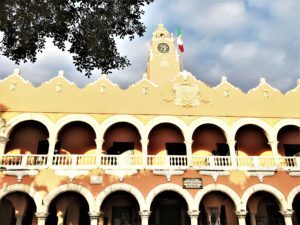
Merida Town Hall ©georgefery.com
____________________________
The severe excesses employed by the friars to denounce the “worship of evil” and to identify priest-shamans, community leaders, and people that ministered to the forbidden ceremonies, was without doubt unjustifiable by today’s standards. It was, however, no different from what was happening in sixteenth century Spain. The events at Mani and other places merely underlines the fundamentalist religious mindset of the times. Locally, even the encomenderos and other colonists and Spanish residents were horrified by what happened at Mani (deLanda – Documento Uno, 1959, XIII/160-1). Let us then shed light on the limited, and at times contradictory, record we have of the Mani “act of faith”, or public burning, that took place on July 12, 1562, to understand what this event was truly about.
Tragedy of the Burning
Mani was the home of the Tutul-Xiu, the Yucatec Maya dynasty that moved its capital from Uxmal to Mani in the thirteenth century. The Xiu were the dominant power in western Yucatan after the fall of Mayapan in 1441. Their fierce antagonists were the Cocom of Sotuta. Mani hosts an old Franciscan monastery, the Paroquia y Convento de San Miguel Arcángel, founded in 1549. Its architecture was adapted to meet the indigenous converts to the new faith, with a large open chapel on its north side. The open chancel was covered with an exposed ramada or open shelter, built at a right angle from the building, to protect parishioners from sun and rain. Facing the monastery is the large esplanade were the bonfires of the auto-de-fe or “act of faith” were placed.
_________________________________
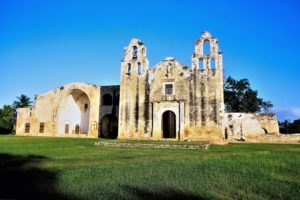
Paroquia y Convento de San Miguel Arcángel at Mani ©georgefery.com
_________________________________
The so called “codices” burnt at Mani, Sotuta, and other locations were not in any way, shape or function related to the better known post-Classic codices. The Spanish called them “books” because they did not know what else to call them. They were in fact canvases mostly conceived of a single sheet of varying size, and locally made from local material, such as the light colored dried bark of trees (the wild fig tree amate or Ficus glabrata for example) soaked and dried, fashioned into thin mats made of woven plant fibers covered with finely ground limestone. The record of country folks were simple motifs related to community and family. They drew their homestead on crude local maps with their milpa or maize fields, family lineage, and their count-of-days calendar system, among others. The number of canvases burned that day at Mani is disputed, but estimates may suggest a hundred or less. In his Relación de las Cosas de Yucatán, de Landa tells us about the sorrow and grief of the local people at their destruction: “We found a large number of books in these characters and, as they contained nothing in which were not to be seen as superstition and lies of the devil, we burned them all, which they regretted to an amazing degree, and which caused them much affliction (McAnany, 1995).
_____________________________

Post Classic Dresden Codex (1250-1350AD) Public Domain
_____________________________
The reason for the limited number of canvases lies in the fact that they were mostly used by halac huinics or lineage heads, the “true righteous men” and principals, while most people were illiterate. Family heads, however, knew enough to record their lineage and a rough description of their property’s location and homestead. Of note is the fact that the glyphs used on the burnt canvases were not the ones of Classic times, for the glyphs on ancient stone stelas could not be read by sixteenth century Mayas. The records of those canvases were important, for they succinctly described information such as the cycles of the sun and moon according to agrarian cycles, numbering structure, time recording method, and concomitant religious filiation. They also recorded secular information on villages, families, water rights and properties. Furthermore, de Landa stresses that several thousand wood artifacts, and small bundles called bultos that contained remains of deified ancestors represented most of the items burned. Also burned were hundreds of small humanlike shaped clay figurines that held ancestral remains. The question then is, if there were a relatively limited number of canvases, were they the only reason why the friars insisted that they be destroyed, or were the canvases, and the wood implements and bundles with ashes of selected forebears, the real aim of the “act of faith”?
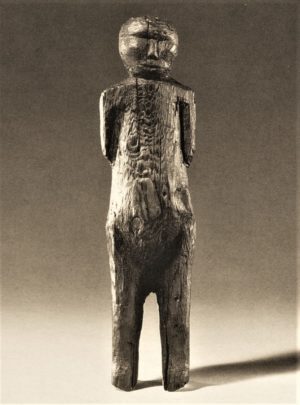
Punuk Wood Figure – Sotheby’s Sale 6733 Public Domain
From time immemorial to this day, the record of ancestors’ predominance in social groups worldwide is at the core of ancient spirituality, silent testimony of filiation to ancestry and patrimony. Figurines representative of deities were made of clay, but those made of wood were especially revered because they were carved to resemble human figurines. De Landa’s description of the process is as follows: “…the people of position made for their deceased fathers wooden statues of which the back of the head was left hollow; they then burned a part of the body and placed its ashes there, then plugged it up; …they then buried the rest and… preserved these statues with a great deal of veneration among their idols” (deLanda – 1959, XXXIII/59). Freedman corroborates the pattern that ancestor veneration is a selective process and does not extend equally to all deceased progenitors (1966). The Punuk (Esquimo) wood figure is the closest to those of 6th century Yucatan, for none have been found to date. The bundle tradition of carrying tutelar gods and ancestors’ remains, especially on migration, can be traced as far back as the Olmec culture (2,500BC), through Maya and Aztec times, as well as in most present-day cultures of the Americas.
These wood and clay representations of ancestors were important family heirlooms, so much so that they were integral to the descendants’ inheritance (deLanda – 1959/XXVII.48). They were intangible witnesses of the family belonging to that ethno-linguistic community, with all the rights attached to household and land. Together with the canvases, they were the family seals of property. The foreign priests did not (or did they?), understand the significance of what they called superstition and idolatry when they burned these “idols.” By destroying these articles, they literally ripped the peoples’ identity, their standing in the community and “title” to their land and property. These facts, therefore, demand that we raise the importance of how and why ancestors fitted into the economy and the daily lives of families, because ancestral traditions lie at the roots of this tragedy.
As in traditional Maya communities today, each maize field holds a foundation shrine dedicated to deified ancestors who left land and other resources to their descendants. At these sites, prayers and incantations take place at each planting-harvesting cycle, as well as at dedicated times throughout the year. Ruth Bunzel, in Barbara Tedlock (1982/95), noted that ancestors are the power whose influence on human affairs is continuous and unremitting since they are the former owners of the house and land. She further added that land is conceived as belonging to the ancestors; one lives upon it by their grace; one does not own land, it is merely loaned to one as a lodging in the world. In the final analysis, ancestors provide a bridge between generations for the benefit of the descendants standing in their community, because ancestors are invoked to legitimize and bring order to daily family and communal existence. De Landa and his friars dismissed the significance of these icons on grounds of idolatry, which in their view was merely a means of escape from the new religion. But was it the only motive, or were the Friars in partnership with local unscrupulous encomenderos and mestizo colonists who were then able, through burning the only indigenous “property record,” to seize “undocumented” land?
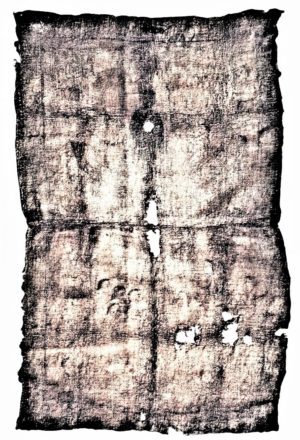
Lienzo de Coachimalco ©ArqueoMex No.38/60
In Mexico today, ancient canvases found in traditional communities are recorded with the National Museum of Anthropology and History (MNA, INAH), as well as with local land survey archives. Under Article 27 of the Agrarian Law the canvases are acknowledged as legal property records. Copies of these ancient documents are still used in land claim resolution and are legally binding between parties. The case of the Lienzo de Coachimalco in the late 1970s illustrates the importance of such records. The rare lienzo or canvas is dated in the first part of the 17th century. It is made of five panels of jolote fibers sewn together, then covered with a thin coat of finely ground limestone, on which are drawn a crude map and figures of the village of Coachimalco. The lienzo is legally recognized as proof of ancestral property and residence by local landowners and they document the descendants’ claim to property.
In the appendices of the 1959 edition of the Relación are testimonies of the collusion between secular and religious members of the Yucatan government in Merida, albeit not for the same reasons. This collusion cannot be understood without bringing forward the Tax List of 1549. This list fixed the levies to be paid by each of the 175 towns in Yucatan and ten in Tabasco, as well as in other towns of the crown to its encomenderos for administrative control over an extensive administrative, military, and religious infrastructure. The taxation in kind was subject to the availability of local resources. It included, among others, manufactured material such as wool mantas or mantles, each made of nine-plus square feet at the rate of four hundred per year for an average town, beeswax (per 100-weights), drums of honey and other items and products, such as corn, beans and other foodstuff, as well as salt and dried fish from coastal communities. The record indicates that, for the year 1549, the levy of 53,285 mantles were collected upon the 175 towns, recorded on the Tax List in Yucatan” (Gates, 1937/213).
The tributes had to be delivered to encomenderos in the city of Merida at the rate of one-third every four months, with pack animals or carts for transportation supplied by the colonists. Indigenous communities had to help the colonists for this task with four Indian workmen for this service, to be fed and housed by him and taught the doctrine of Christianity. Material and products were also assigned to the crown and religious orders. For the following years, the levies varied with the size of towns, which steadily grew by reason of the forced resettlement, or repartimiento de indios of indigenous villages, when they were burned to the ground to further the policy for better socio-economic and religious control.
Among numerous testimonies is a report issued on March 15, 1563, by Hernando Dorado, Royal Notary in Merida, the ancient Ti’ho, witnessed by upstanding citizens who were deeply distressed by the abuses sustained by indigenous people at the hands of certain members of the church and the colonists. The report was sent to the Vice Royalty of New Spain in Mexico City, which was concerned with persistent rumors of civil unrest in the province. The central and local governments needed a stable church-state cooperation for the sake of socio-economic stability and development. Dorado’s report is significant in describing the use and abuse of power at the time, notably the appearance on the scene of a colorful figure, the alcalde mayor of Merida, Diego Quijada in 1561, which sheds a disturbing light on the events.
The 1563 and 1565 reports describe the events that happened at Mani, Sotuta, and other towns and villages. In Mani, flogging and burnings at the stake by the friars were directed by de Landa, assisted by friars Miguel de la Puebla, Pedro de Ciudad Rodrigo, and Juan de Picaro, referred to as “ordinary inquisitors” of the Inquisition. Mayor Diego Quijada also attended the dramatic events together with colonists. When convicted of lesser charges, Indians had their head shaved (de Landa – Documento Uno, 1959/147). and sent to forced labor for ten years or less as indentured servants in the haciendas of encomendoros and mestizo colonists’ friends of the mayor.
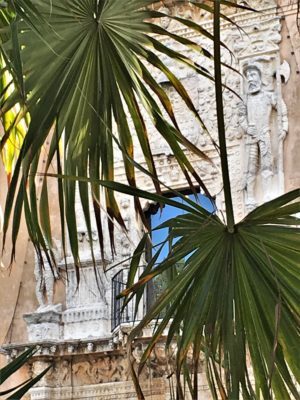
Palacio Montejo, Merida ©georgefery.com
Penalties with payment in kind by indigenes were collected; the report mentions 4,340 gold pesos, 125,000 cacao beans (the local currency), as well as other charges for lesser penalties (de Landa – Documento Uno, 1959/149). The friars went further in desecrating the graves of indigenous ancestors by removing the buried bones which were then scattered in the fields or thrown into bonfires (de Landa – Documento Uno,1959/148). This was not an act of lunacy — it was grounded in a religious rationale that, by showing publicly the Maya’s ancestors’ impotence in the face of extreme adversity, it would achieve the eradication of ancestor worship.
The secular-temporal collusion in the region, if not always as extreme as at Mani, was the result of the tri-partite failure between the local governments, the encomenderos, other colonists and the religious order, each with their own agenda. This relationship went astray as such relationships often do and was highly damaging to the Yucatan socio-economic stability under the mayor and his accomplices. The friars, sanctioned by their custodian, ignored the mandate of the Holy Inquisition to cease forced conversion and maltreatment of the local people, while the mayor and his associates were driven by greed. Manuscript letters in Yucatec to the viceroy in Mexico City, signed by three governors, describe the brutality of the Franciscans, and asked for help and redress that often came too late. In many instances, local rage against the invaders ravaged the land. Near Valladolid, a revolt took the lives of seventeen Spaniards and several hundred mestizos. The villagers cut the hands and feet of their oppressors and sent them to towns and villages on the peninsula to sow a resistance movement that never had a chance to take hold.

Letter to the Viceroy, Page 3 – Archivas de Indias. Public Domain
The damning 1563 report is supported two years later by another, dated March 25, 1565, from Merida again, addressed to the Viceroyalty of New Spain in Mexico City, and to the Council of the Indies in Spain by the Royal Notary, Sebastian Bazques (de Landa – Documento Uno-1959/143-157). This second report confirms the first regarding long lasting abuses of power that resulted in serious economic damage to the province while inciting dangerous restlessness within the indigenous population. In his A Short Account of the Destruction of the Indies, published in 1552, by the Dominican friar Bartolomé de las Casas, he relates a situation then widespread in New World territories. The book raised an uproar in Spain and all over Europe at the time. The Dominican friar’s supplications for relief notwithstanding, the destruction of many idols collected during idolatry trials by the Inquisition in the Yucatan was widespread and is found to occur in every chronicle of every entrada well into the seventeenth century.
That is the deplorable condition the Franciscan Francisco de Toral (1502-1571), the first bishop of the Diocese of Yucatan, found on his arrival in 1562. He quickly identified the ills that plagued the province and focused his attention on de Landa’s treatment of the native people. De Toral was appalled at their subjection and abuse and skeptical about the use of physical punishment to exert confessions. It was obvious to de Toral that de Landa ignored the orders of the Crown and that of the Inquisition and exceeded his ecumenical mandate. The antagonism between the two priests led de Toral to force de Landa to return to Spain in 1563 to face charges of abuse of his religious obligations at the Council of the Indies’ court in Seville. De Toral freed hundreds of Mayas that de Landa had imprisoned without cause, except for those guilty of instigating the egregious crimes of idolatry and human sacrifice.
The de Landa Legacy
When he first set foot on the peninsula in 1549, de Landa’s initial zeal to convert was driven not only by faith but also by an inquisitive mind genuinely interested in the land and its people. He crisscrossed most of the Yucatan bare foot and made valuable notes that went beyond the indigenous people’s beliefs and religious practices, and into all aspects of their lives. His first-hand observations embraced community and family organization, children education, burial practices, architecture, planting techniques and cycles, the calendar and numbering system, harvested products storage and distribution, the symbology of their writing, festivals, justice, hospitality, the fauna and flora of the land, and other relevant facts on communal and family daily life.
After his removal as “Provincial” in Merida by Bishop de Toral and his return to Spain in 1563, he took advantage of his suspension to write his seminal Relación de las Cosas de Yucatán, the most comprehensive ethnographic document of his time. There is little doubt, however, that the “Relación was written in support of his claims to his duties and as exculpatory evidence to counter the accusations leveled against him.
His field work and observations, however, have been indispensable to anthropologists and scholars for the last hundred years. Among his invaluable notes, one stands out: his record of the Maya writing system based on information given to him by town and village spiritual and secular elders that phonetically and graphically helped him match glyphic symbols with the Spanish alphabet. Glyphs and letters did not always match, however, resulting in inconsistencies and duplicates that could not be resolved. Not until 1952 did the Soviet linguist and epigrapher Yuri Valentinovich Knorozov (1922-1999) realize that the transcription was not that of an alphabet but the ideograms of a syllabary (such as Egyptian hieroglyphs). It was a momentous breakthrough in Maya glyph decipherment.
_____________________________
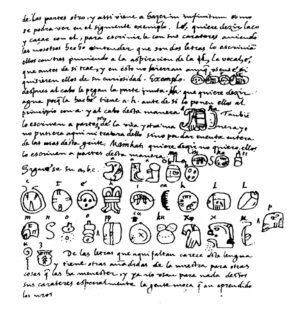
De Landa’s Notes on Yucatec-Spanish Alphabet Public Domain
_____________________________
De Landa stood trial in Seville where his actions were strongly condemned, but the investigation by scholars of the Council of the Indies absolved him in 1569 on the grounds that he acted within the bounds of his ecumenical mission, and under the provisions of the Holy Inquisition. Many religious and lay people in Yucatan were clamoring for his return, both with the viceroy in Mexico and the court in Spain. While retired in the Antonio de la Cabrera convent, he was not forgotten by King Philip.II. After consultation with the Council of the Indies and Franciscan elders, the king approved the appointment of Diego de Landa in 1572 as the second bishop of Yucatan, succeeding Bishop de Toral, who died in Mexico City in 1571. The second bishop landed in Campeche, Yucatan, in early 1573, together with a retinue of thirty Franciscan friars Philip II granted the Merida bishopric to further ecumenical work. After serving the Franciscan order for thirty-eight years, most of this time in Yucatan, Diego de Landa died of natural causes on April 29, 1579; he is buried in Merida’s cathedral.
______________________________
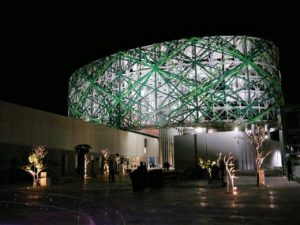
Merida Great Maya Museum Public Domain
______________________________
Bibliography
Diego de Landa C. – Relación de la Cosas de Yucatán, Ediciones Porrua, 1959
William Gates – Yucatán Before and After the Conquest – Forgotten Books, 1937
Diego Lopez de Cogolludo – Historia de Yucatán – Linkgua, 2006
Mircea Eliade – Shamanism, Archaic Techniques of Ecstasy – Princeton-U, 1964
Fash, Agurcia Fasquelle – Visión del Pasado Maya – Centro Editorial, 2003
Joan Halifax – Shamanic Voices – Arkana Book, New York, NY,1979
Stephen Houston – The Life Within – Leslie Fitch, 2014
Barbara Tedlock – Time and the Highland Maya – University of NM Press, 1982
R.P. Ximenez – Popol Vuh – Editorial José P. de Ibarra, Guatemala, 1701 (1973)
Diego Duran – Historia de las Indias de Nueva España – Imp. Escalante, 1880
David Freidel, Linda Schele, Joy Parker – Maya Cosmos, William Morrow, 1993
L. Mendez Martinez – Historia Mayab’ – Asociación Maya Uk’Ux’B’e, 2008
Patricia A. McAnany – Living with the Ancestors – University of Texas Press, 1995
Nelson A. Reed – The Caste War of Yucatán – Stanford University Press, 2001
Bartolomé de las Casas – Brevísima Relación de la Destrucción de las Indias – 1965
Éric Taladoire – Les Trois Codex Mayas – Balland, Paris, 2012
Ruth Bunzel – Chichicastenango: A Guatemalan Village – Washinton Press.U, 1952




